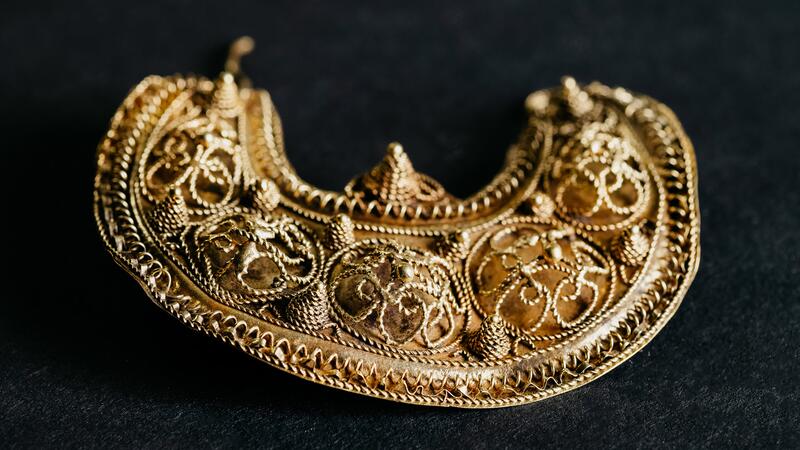Dutch Historian Discovers Medieval Jewels
The 1,000-year-old find is now on display in the Dutch National Museum of Antiquities.

Ruijter found a treasure trove of medieval jewelry and coins dating back more than 1,000 years.
He reported his find to Archeology West Friesland, and his discovery is now on display in the Dutch National Museum of Antiquities.
“Gold jewelry from the high Middle Ages is extremely rare in the Netherlands,” said the museum.
The treasure trove included four gold earrings in a crescent moon shape, two gold leaf pieces that fit together, and 39 small silver coins.
The coins helped the museum to piece together how old the treasure was and shape the story of why, perhaps, it was found buried in the ground.
The coins, believed to be from 1200 to 1250, were from the Diocese of Utrecht, which included several counties, and from the German empire, with the youngest copies made around 1248 when King William II ruled the Holy Roman Empire. Small pieces of textiles indicate they were wrapped in a cloth or bag.
This would mean the jewelry was already nearly two centuries old when it was likely hidden in the ground, said the museum.
This was an important and troubled time in the country’s history, when there were wars between West Friesland and the county of Holland. Count Willem II died during these wars, not far from where the jewelry was found.
The museum’s theory is that these jewels and coins were likely among someone’s cherished possessions, buried out of sight during the wars.
“This makes the treasure find of great significance for the archaeology and history of North Holland and West Friesland, and even of national and international importance,” said the museum.
SEE: The Medieval Jewelry and Coins Discovered in the Netherlands
The most important objects, according to the museum, are the earrings. The first pair feature engraved scenes, including one depicting a man with rays surrounding his head, believed to be a portrait of Jesus Christ, also known as “Sol Invictus,” or the “unconquered sun.”
The other pair has intricate filigree decorations. One earring is badly damaged, likely due to being hidden under plowed soil for centuries.
“The jewelry is decorated on one side and has fragile suspension brackets. This suggests that they were probably not pierced through ears, but were worn on a hood or a headband,” said the museum, noting German images from the same time period show a similar style.

The two gold leaf-shaped pieces fit together, and are believed to have been worn attached to clothing due to the small textile fibers that were found.
The jewelry and coins belong to the finder, Ruijter, but are temporarily on loan to the museum.
They will be on display in the Temple Hall of the museum until mid-June. Beginning Oct. 13, the find will be part of a new temporary exhibition, titled “The Year 1000.”
The Latest

“Bridgerton” actresses Hannah Dodd and Claudia Jessie star in the brand’s “Rules to Love By” campaign.

Founded by jeweler and sculptor Ana Khouri, the brand is “expanding the boundaries of what high jewelry can be.”

The jewelry manufacturer and supplier is going with a fiery shade it says symbolizes power and transformation.

How Jewelers of America’s 20 Under 40 are leading to ensure a brighter future for the jewelry industry.

The singer-songwriter will make her debut as the French luxury brand’s new ambassador in a campaign for its “Coco Crush” jewelry line.


As the shopping mall model evolves and online retail grows, Smith shares his predictions for the future of physical stores.

The trade show is slated for Jan. 31-Feb. 2 at The Lighthouse in New York City's Chelsea neighborhood.

Roseco’s 704-page catalog showcases new lab-grown diamonds, findings, tools & more—available in print or interactive digital editions.

January’s birthstone comes in a rainbow of colors, from the traditional red to orange, purple, and green.

The annual report highlights how it supported communities in areas where natural diamonds are mined, crafted, and sold.

Footage of a fight breaking out in the NYC Diamond District was viewed millions of times on Instagram and Facebook.

The Signet Jewelers-owned store, which turned 100 last year, calls its new concept stores “The Edit.”

Linda Coutu is rejoining the precious metals provider as its director of sales.

The governing board welcomed two new members, Claire Scragg and Susan Eisen.

Sparkle with festive diamond jewelry as we celebrate the beginning of 2026.

The master jeweler, Olympian, former senator, and Korean War veteran founded the brand Nighthorse Jewelry.

In its annual report, Pinterest noted an increase in searches for brooches, heirloom jewelry, and ‘80s luxury.

Executive Chairman Richard Baker will take over the role as rumors swirl that a bankruptcy filing is imminent for the troubled retailer.

Mohr had just retired in June after more than two decades as Couture’s retailer liaison.

Shekhar Shah of Real Gems Inc. will serve as president of the Indian Diamond & Colorstone Association in 2026.

This year’s good luck charm features the mythical horse Pegasus, and is our first Piece of the Week of the new year.

Articles about crime, engagement rings, and a necklace worn in the World Series generated the most interest among readers.

As part of the leadership transition, Sherry Smith will take on the role of vice president of coaching strategy and development.

It marks the third time the country has headed the Kimberley Process. Ghana will serve as vice chair.

The new Bulova x Stetson designs highlight two animals often associated with the American West—the bison and the Texas Longhorn.

Its residency at Yamron Jewelers will run through May 2026.

From influential executives to innovative designers, we pay tribute to the people we said goodbye to this year.































